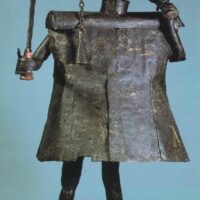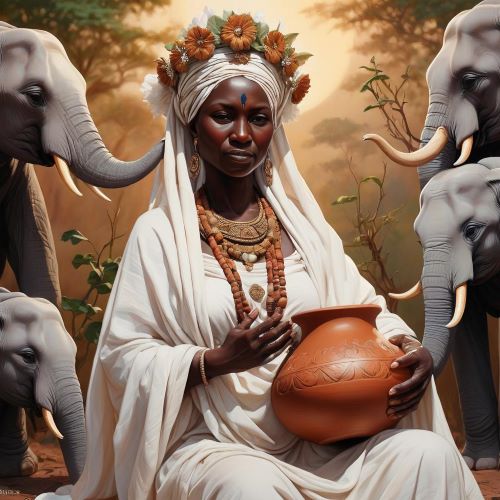Gu : God of War
Listen
At a glance
| Description | |
|---|---|
| Origin | Ewe Mythology, Fon Mythology |
| Classification | Gods |
| Family Members | Mawu (Father), Lisa (Mother) |
| Region | Benin, Togo, Ghana |
| Associated With | War, Blacksmithing |
Gu
Introduction
Gu is a notable deity in the Ewe and Fon mythologies of West Africa, particularly among the peoples of Togo, Ghana, and Benin. This god is revered for embodying knowledge, intelligence, and creativity, reflecting the cultural values of these communities, where wisdom and divine guidance are essential for prosperity and development. Gu’s role extends beyond mythology into daily life, symbolizing strength, protection, and craftsmanship, especially in blacksmithing and war. His influence is evident in traditional beliefs, rituals, and modern folklore, making him a powerful and enigmatic figure in these cultures. This article will delve into Gu’s physical traits, family connections, alternative names, powers, abilities, and his impact on contemporary society.
Physical Traits
In Ewe and Fon mythology, Gu is depicted with distinct physical traits that underscore his divine status. He is often envisioned as a tall, imposing figure, exuding both strength and agility, with a slender yet muscular build that commands respect. His skin, while humanoid in texture, is said to emit a celestial glow, highlighting his divine origins. Interpretations of Gu’s appearance vary, with some narratives describing him as a gaunt, skeletal figure with piercing eyes, while others present him as more humanoid, though sometimes with a deformed or monstrous aspect. He is frequently linked to darkness and shadows, often portrayed as a being of the night.
As a god of war and blacksmithing, Gu is typically shown as a fierce warrior, wielding an iron sword that symbolizes his control over metal and martial skill. His robust physique emphasizes his mastery of blacksmithing, and his facial features, including high cheekbones and a long nose, lend him a regal appearance. Artistic representations often adorn him with intricate ornaments and spiritual markings, such as beads and patterns, that reflect his elevated status and the wisdom he embodies.
Family
Gu’s familial ties are central to his significance in Ewe and Fon mythology. He is often depicted as the offspring of Mawu and Lisa, the supreme deities representing the moon and sun, embodying femininity and masculinity, respectively. This dual lineage positions Gu as a mediator between opposing forces, symbolizing balance and harmony within the universe. His connection to both parents highlights his role as a unifying figure, integrating the nurturing aspects of Mawu with the powerful, illuminating qualities of Lisa.
In some narratives, Gu has several siblings, each governing various aspects of existence and the cosmos. These familial relationships are woven into myths that emphasize collaboration, rivalry, and the collective sharing of knowledge, reflecting the communal values of Ewe and Fon societies. Gu’s interactions with his divine siblings often serve as allegories for human relationships, underscoring the importance of unity and mutual respect.
Alternatively, some stories portray Gu as a more solitary figure, disconnected from a clear family lineage or direct ties to other deities. In these accounts, his association with the spirit world or the underworld suggests a different type of connection to supernatural entities, emphasizing his role as a bridge between the mortal and divine realms. Regardless of the version, Gu’s family connections underscore his critical position in the pantheon, highlighting his balanced nature and integral role in the cosmology of the Ewe and Fon peoples.
Other names
Gu is known by several names across the Ewe and Fon communities, each highlighting different facets of his nature and responsibilities. One of his prominent names is “Gu-Dzo,” meaning “the god of knowledge,” which underscores his role as a beacon of wisdom and enlightenment, guiding people towards understanding and intellectual growth. Another name, “Gu-Agbo,” translates to “the god of creativity,” emphasizing his influence as a creative force that inspires innovation and new ideas. These names reflect the varied aspects of Gu’s character, showcasing his importance as a protector, wise guide, and creative spirit.
In broader West African traditions, Gu’s influence extends beyond the Ewe and Fon cultures. For instance, in the Yoruba religion, he is known as Ogún, the god of iron and war. This title reflects the interconnected cultural heritage of the region and highlights his significance in different spiritual practices. The array of names attributed to Gu across these cultures illustrates his multifaceted nature and the diverse ways in which he is revered and worshipped.
Powers and Abilities
Gu is revered for his exceptional powers and abilities, which embody the core values of the Ewe and Fon peoples. One of his most prominent abilities is to impart knowledge and wisdom, often invoked in prayers and rituals by those seeking clarity and guidance during challenging times. His insights are believed to surpass human comprehension, leading to harmonious living and prosperity.
Gu is also celebrated for his creative prowess, inspiring arts, crafts, and innovation within his communities. He is closely linked to cultural expressions like storytelling and music, and many artists and musicians seek his inspiration before beginning their work, trusting in his divine influence to enhance their creativity and skills.
Beyond his role as a source of wisdom and creativity, Gu is also regarded as a protector and guide. He is believed to have the power to ward off evil spirits and misfortune, safeguarding his followers from harm. This protective aspect underscores the importance of divine intervention in ensuring the well-being of communities.
In some traditions, Gu is associated with darker, more fearsome powers. He is believed to have control over misfortune, capable of bringing bad luck, illness, or disaster to those who offend him. Gu is also said to wield control over the weather, with the ability to summon storms or cause droughts. Some narratives suggest he can possess individuals, influencing their behavior in harmful ways, or communicate with the dead, acting as a bridge between the living and the deceased.
Gu’s powers are further amplified by his mastery of blacksmithing and craftsmanship. His unparalleled skill in working with metal and fire allows him to forge weapons and tools of extraordinary quality, symbolizing both creation and destruction. As a god of war, he is a formidable warrior, embodying immense strength and combat prowess. His association with the sun enhances his divine status, representing his role as a guardian and illuminator of the universe.
Modern Day Influence
In contemporary society, Gu maintains a significant presence among the Ewe and Fon peoples, influencing various aspects of daily life and cultural practices. His teachings and symbolic meanings are integrated into rituals and ceremonies, especially during festivals where storytelling traditions celebrate Gu’s wisdom, creativity, and respect. This integration helps preserve the cultural heritage and values associated with Gu, reinforcing his role in guiding and inspiring the community.
Gu’s influence extends into the arts, literature, and performance, where he inspires a range of creative expressions. Artists often draw on his stories to create works that both celebrate and educate about their cultural heritage. Additionally, Gu’s narratives are studied in academic discourse, highlighting their historical and sociological importance and contributing to a broader understanding of West African mythology.
Recent years have seen a revival of traditional beliefs among younger generations, driven by a desire to reconnect with cultural roots. This resurgence includes educational programs and workshops that focus on mythologies like Gu’s, ensuring that his teachings continue to be relevant. Gu’s legacy also persists in modern cultural practices and artistic expressions, reflecting his enduring influence and the ongoing relevance of his symbolic power in today’s world.
Related Images
Frequently Asked Questions
What is lorem Ipsum?
I am text block. Click edit button to change this text. Lorem ipsum dolor sit amet, consectetur adipiscing elit. Ut elit tellus, luctus nec ullamcorper mattis, pulvinar dapibus leo.
What is lorem Ipsum?
I am text block. Click edit button to change this text. Lorem ipsum dolor sit amet, consectetur adipiscing elit. Ut elit tellus, luctus nec ullamcorper mattis, pulvinar dapibus leo.
What is lorem Ipsum?
I am text block. Click edit button to change this text. Lorem ipsum dolor sit amet, consectetur adipiscing elit. Ut elit tellus, luctus nec ullamcorper mattis, pulvinar dapibus leo.
What is lorem Ipsum?
I am text block. Click edit button to change this text. Lorem ipsum dolor sit amet, consectetur adipiscing elit. Ut elit tellus, luctus nec ullamcorper mattis, pulvinar dapibus leo.
What is lorem Ipsum?
I am text block. Click edit button to change this text. Lorem ipsum dolor sit amet, consectetur adipiscing elit. Ut elit tellus, luctus nec ullamcorper mattis, pulvinar dapibus leo.







